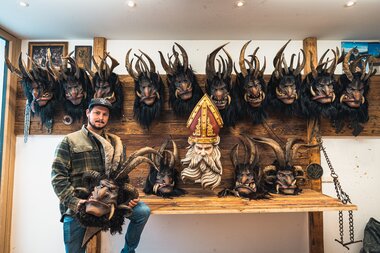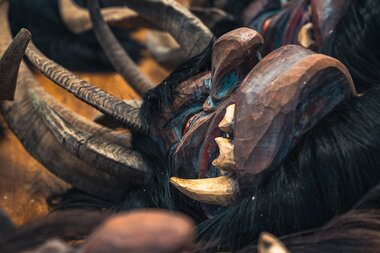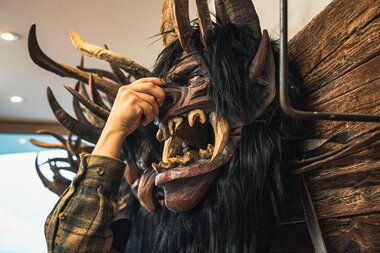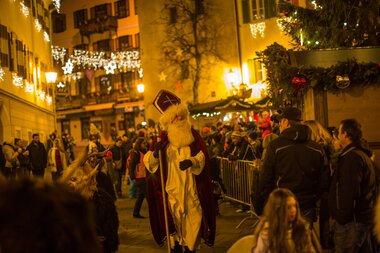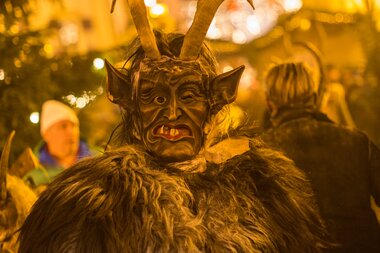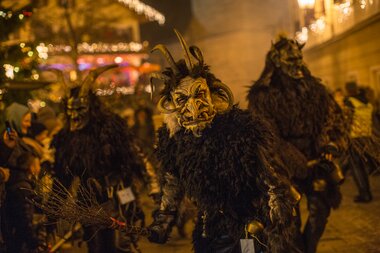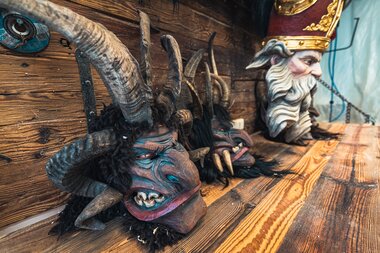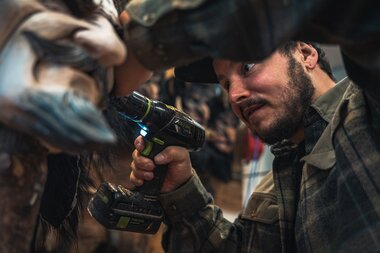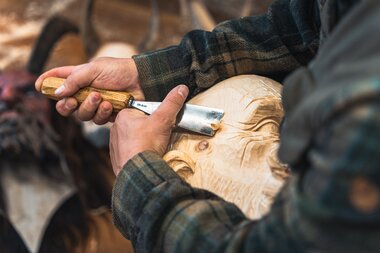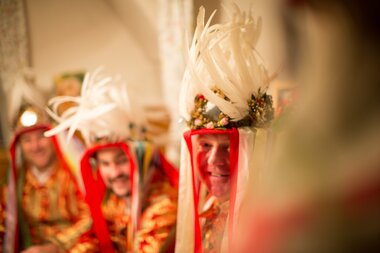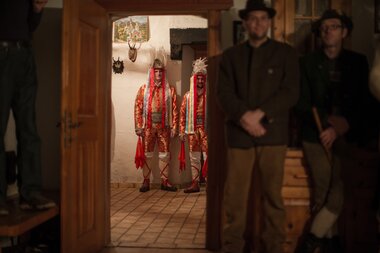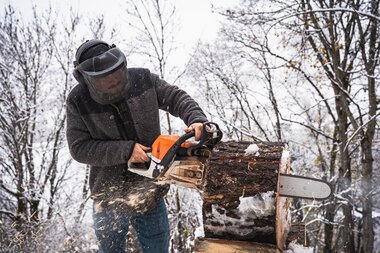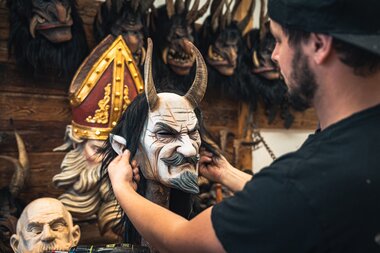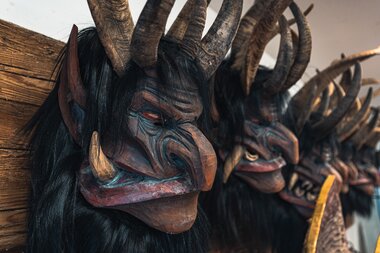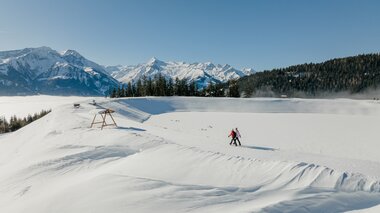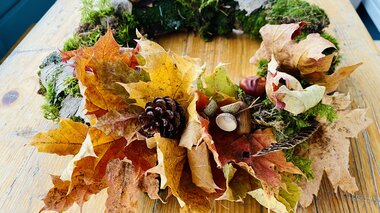A visit to mask carver Arthur Moinat
When it gets dark in the days around 5 and 6 December, you can hear them from far away - and then even the bravest of hearts beat a little faster: the Krampuses are on their way! They also have Arthur Moinat to thank for their eerie appearance: the woodcarver makes the elaborate masks for Krampuses and Perchten. We visited him at his workshop in Zell am See and talked to him about tradition, the fascination of the scary and his passion for woodcarving.
During our visit, Arthur Moinat has just finished the most stressful weeks of the year: "Until mid-November, all the customers, including many groups - the so-called "Passers" - come to pick up their masks. There is quite a lot going on in the workshop". Now that his wood-carved masks are really coming into use, things are a little quieter for him - at least until January, when the first customers come back to order their masks for next year.
Of Schirchperchten & Krampuses
Arthur Moinat's job is to fit out the scariest characters of the (pre)Christmas season: He carves wooden masks for Krampuses and "Schirchperchten" (ugly Perchten), who appear together with the good "Schönperchten" (beautiful Perchten). Both customs - the Krampuses and the Schirchperchten - are firmly anchored in Salzburg tradition, but they differ fundamentally: the Schirchperchten are out and about around Christmas time and the turn of the year during the Twelve Nights of Christmas.
With their loud jingling of bells, they are supposed to drive out the winter spirits. And touching the horse's tails they carry brings good luck, blessings and fertility. The Krampus, on the other hand, is the punishing and admonishing companion of Saint Nicholas, and is out and about around the first week of December.

It is not only their origin and the days in which they appear that distinguish Krampus and Schirchpercht, their looks are also different. Schirchperchten masks are usually only painted in three colours - black, red and white - and they have three pairs of horns. Schirchperchten also wear sheepskin or goatskin coats and large bells. The Krampus, on the other hand, is modelled on the figure of the devil and is therefore much more varied in his appearance.
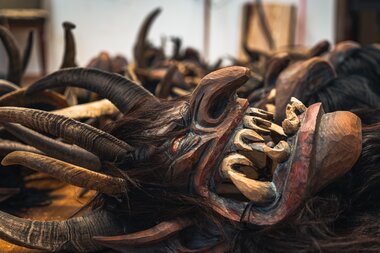
Traditionally, the Krampuses were only on the move on 5 December, Krampus Day, and on 6 December, St. Nicholas' Day - but today the big parades begin in mid-November and the devilish fellows continue their mischief until after St. Nicholas' Day: "But you don't have to be afraid of either the Perchten or the Krampuses - unless you have burdened yourself with sins during the year," smiles Arthur Moinat, who has been a Krampus himself since childhood.
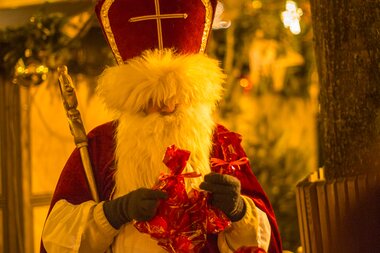
In the beginning there was fear
Has Arthus always been fascinated by the tradition of the Krampuses? "Everyone always assumes that when they hear about my profession," says the 30-year-old. But in fact, it was more the case that the Pinzgau native, as a child, was rather afraid when the Krampuses were out and about. "But my mother was a sculptress and she then carved a first Krampus mask together with me - when I was 5 or 6 years old." With this mask, he then started going as a Krampus himself. "The topic quickly fascinated me and has never completely left me," he recalls. In 2010, he started carving Krampus masks himself, modelling each mask beforehand and then making them out of wood.

He taught himself the craft of carving - by practising, practising and even more practising: While working as an interior decorator, he went to the workshop to carve every evening after work. "Carving has been meditative for me ever since. I enjoy it a lot and it always challenges me. The most beautiful thing about it is the process, how something new emerges cut after cut, and how you breathe life into a block of wood," he says about his passion. In the meantime, he has turned this passion into his profession.
A scare as authentic as possible
For his Krampus masks, he always makes sure that the masks look as authentic as possible. "I don't want to create any fiction with my masks, a mask must always be recognisable as a mask. To me, that is the only requirement. Ideally, a mask should look as if it has been in the attic for 30 years, waiting to be used," Arthur says of his style. He makes his masks from wood as well as aluminium, bronze or brass. Plastic horns are out of the question for him. "I hardly use any plastic, but horns and skins from mostly native animals. So, I have a profession with which I produce almost no waste - and who can claim something like that today?" he says, not without pride.
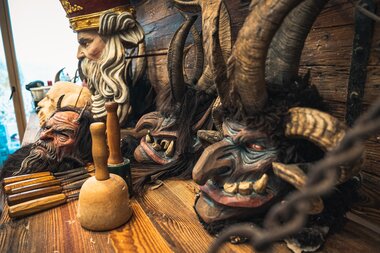
His works now have a large following: the few masks he carved for his friends and himself in the beginning have become many over the years - Arthur cannot say exactly how many there are each year. His customers appreciate his style and are looking for authentic masks. "Some clients come with quite clear ideas for their mask. But I like it even better when I can work according to my own ideas. You always have to adapt to the wood, work with grains and knotholes. The faces are already hidden in the wood," he explains.
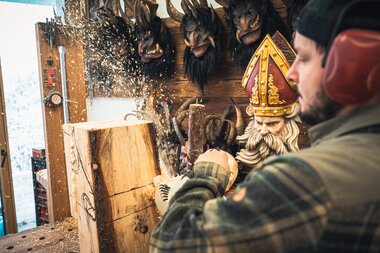
The Krampus on his mind all year round
But the most difficult part of carving a mask is not just the carving itself: It is also the painting that makes the difference. Arthur works with a sculpture painter for his masks, but he also paints about half of them himself. The prices for his masks start at around 600 Euros and rise depending on the design. At Arthur's workshop in Thumersbach (a district of Zell am See), he actually carves all year round - except for a few weeks in December. "I'm at my best in the 'flow' in spring. Then all the orders are completed and I can concentrate on my work all day, even on Saturday and Sunday I'm in the workshop," he says.
Does he sometimes suffer from workshop fatigue? "No, I still enjoy my work very much," he says. And it always fills him with joy and pride when he sees the Passe groups wearing his masks at performances, while experiencing the immediate reactions of the audience at the same time.
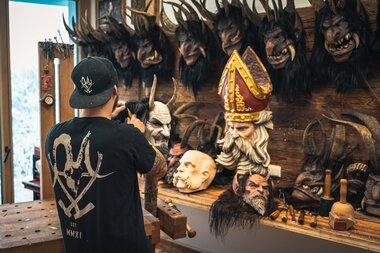
In the past, he used to travel all over Austria as Krampus or Percht up to ten times a year. Today, Arthur only dresses up - or rather puts on his animal fur - rarely: then he appears at some runs as Krampus or Percht.
However, he prefers to make house calls or to travel with the Tresterer group of Zell am See as the "Schircher". This special custom can now only be experienced in a few communities (including Zell am See). The ancient Schönperchtentanz (dance of the beautiful Perchten) is a kind of begging custom in which people go from house to house. "It's nice to play with the audience," he says. "It's exciting to see how people who actually know you well react to you when a mask makes you unrecognisable," he explains the fascination.
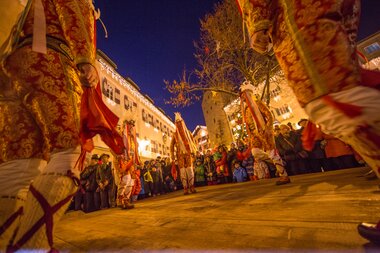
DON'T BE AFRAID!
And what does he say to people who are afraid of this tradition? "Personally, I would never take off the mask. I think if you are Krampus, then you are Krampus - and this figure should not be demystified under any circumstances. But especially with children, I like to get down to eye level and show that we're actually friendly if they've been good all year." Children are also welcome in his work shop, of course: Then they see that, above all, a special craft is behind the scary mask.


